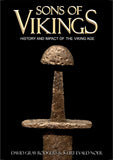Thanks for visiting our blog! As a thank-you, enjoy 15% off your first order in our online Viking Shop with the discount code BLOG15.
The Vikings, famed for their daring raids and seafaring exploits, left a lasting impact on the history and culture of medieval Europe. But where exactly did these Norse warriors launch their raids, and what were the consequences of their actions? In this blog post, we’ll delve into the geographical scope of Viking raids, tracing their footsteps across Europe and beyond.

England: One of the primary targets of Viking raids, England suffered repeated incursions by Norse warriors from the late 8th century onwards. Places such as Lindisfarne in Northumbria (793 AD) and Jarrow (794 AD) were among the earliest targets, followed by attacks on major cities like York and London. The Anglo-Saxon Chronicle, a primary source from the period, provides vivid accounts of Viking raids on England, documenting the devastation and terror wrought by these invaders.
France: The coastlines of France were also frequent targets of Viking raids, with Norse longships plundering towns and monasteries along the Seine and Loire rivers. One of the most infamous raids occurred in 845 AD when Vikings sailed up the Seine and besieged Paris, demanding a ransom in exchange for sparing the city. The Annals of St. Bertin, a contemporary chronicle, offers valuable insights into Viking activities in France during this period.
Ireland and Scotland: The western isles of Ireland and Scotland were not immune to Viking raids, with coastal settlements such as Dublin and Limerick becoming major Viking strongholds. The Irish Annals, including the Annals of Ulster and the Annals of the Four Masters, provide detailed accounts of Viking raids and settlements in Ireland, shedding light on the impact of Norse expansion in the region.
Russia, Ukraine, and Eastern Europe: The Vikings ventured eastward along river routes, penetrating deep into the heart of Eastern Europe and establishing trade networks with the Slavic peoples. The Primary Chronicle, a historical narrative compiled in medieval Kievan Rus’, documents the arrival of the Varangians (Vikings) in Eastern Europe and their interactions with the local population.
North Atlantic: Perhaps the most ambitious of Viking expeditions were those to the North Atlantic, where Norse explorers colonized distant lands such as Iceland, Greenland, and eventually North America. The Icelandic Sagas, including the Saga of the Greenlanders and the Saga of Erik the Red, provide accounts of Viking voyages to these remote regions, detailing their encounters with indigenous peoples and the challenges of settlement. While the Vikings and the Native Americans did fight several times, according to the sagas, there is no account of Vikings raiding America’s indigenous peoples. There was trade between the two groups, though it proved ill-fated. We can only wonder what Viking and Native American interaction was like after our accounts go silent around 1015 or so.
In conclusion, Viking raids were not limited to a single region but spanned across Europe and beyond, leaving a trail of destruction and cultural exchange in their wake. Through primary sources such as chronicles, annals, and sagas, we gain valuable insights into the motivations, tactics, and consequences of Viking raids, illuminating a pivotal chapter in the history of the medieval world.
Curious about your own true heritage?
Most people know where their grandparents are from, but where are THEIR grandparents from? You might be surprised. DNA test results have come a long way and can now trace the various journeys of your ancestors going back over a thousand years. For quality results (the most comprehensive ancestry breakdown on the market), we highly recommend using 23andMe. Please note that if you end up making a purchase, we may earn a small commission at no extra cost to you.
Primary Sources:
Anglo-Saxon Chronicle (England)
Annals of St. Bertin (France)
Irish Annals (Ireland)
Primary Chronicle (Eastern Europe)
Icelandic Sagas (North Atlantic)
Sons of Vikings is an online store offering hundreds of Viking inspired items, including Viking jewelry, Viking clothing, Drinking horns, home decor items and more.
To learn more about Viking history, we recommend our 400+ page, self titled book that is available here.



